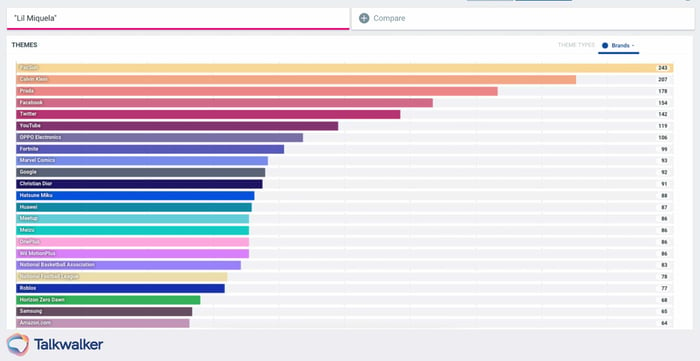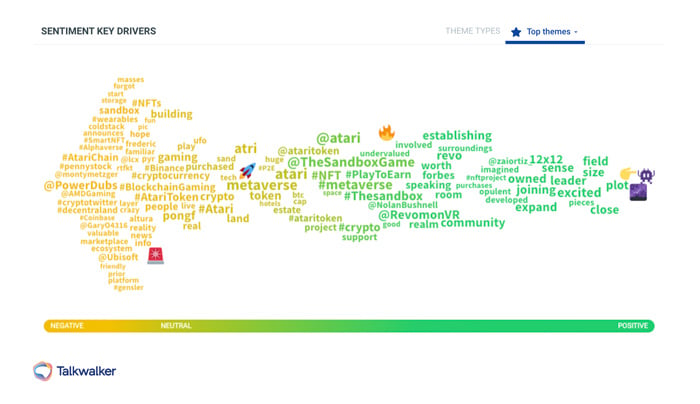Is your brand tomorrow-ready? Shape tomorrow with your consumers
What is the metaverse, exactly?
A lot has been said recently about the metaverse - but what is it really? The metaverse is a growing playground in which communities, ideas, and even brands, can flourish together.

With Talkwalker's Quick Search, we can see that the daily volume of conversations around metaverse broke out in Q3 2021, at the same time Mark Zuckerberg renamed Facebook to Meta.
The metaverse is a digital space that is always-on and immersive - one puts on a headset and sees, and can operate within, a digital world. It can be a digital portal, or powered by algorithms or blockchains.
What are the major metaverse platforms?
Some platforms or games that can be affiliated to the metaverse galaxy have existed for a long time. Second Life and Minecraft are probably the most famous of them. But in 2017, Fortnite launched and immediately shook up the industry. Without realizing it or being able to put a name on the phenomenon, the metaverse was brought into millions of homes and a new generation of users embraced a new way of playing, learning, and socializing.
When I watched the Meta Introduction Keynote and Mark Zuckerberg flying into this new world, it reminded me of Roblox. At the intersection of gaming, social experience, and virtual reality, Roblox was also a pioneer.
The time has come for the #metaverse to come together in celebration of a more positive future. Experience the culture, the music, and the world of @InTheHeights!
Bring your best selves to the block party of the year: https://t.co/a3aWeyERtM #InTheHeightsMovie pic.twitter.com/FYq9Psj0Ks
— Roblox (@Roblox) June 4, 2021
Roblox's vision for the metaverse is to “create a platform for immersive co-experiences, where people can come together within millions of 3D experiences to learn, work, play, create, and socialize.” In April 2020, Roblox Corporation told Bloomberg that “two-thirds of all U.S. kids between 9 and 12 years old use Roblox, and it’s played by a third of all Americans under the age of 16.” Needless to say, Roblox completely took over the market.
Roblox is not the only metaverse platform that has grown considerably over the past year. Decentraland and Sandbox, both decentralized, community-driven ecosystems where creators can share and monetize assets and gaming experiences on the Ethereum blockchain, have both seen interest in their platforms skyrocket over the past two years.
Walk right in and get immersed in art - Decentraland Art Week is on. https://t.co/TT94rVy4HL pic.twitter.com/afZ3hvQdxU
— Decentraland (@decentraland) August 24, 2022
A tweet from Decentraland, a decentralized 3D virtual reality platform that consists of 90,601 parcels of land.
Both of these platforms are blockchain-based or NFT-based metaverse. A bit of a mouthful, but it is in fact pretty easy to understand. In these virtual worlds, the land, buildings, avatars, and even names can be bought and sold, often using cryptocurrency
Now, let’s compare the volume of conversation about these metaverse platforms with Talkwalker’s Quick Search. Roblox and Fortnite are leading the race and are the most talked about platforms, ahead of NFT-based metaverses Sandbox and Decentraland which have likely suffered from the NFT crisis and the crypto winter that began in late 2021 and continues in 2022.

This chart was generated with Talkwalker’s Quick Search, designed to show the top trending topics for any given category, country or language, right as they happen.
How can brands reinvent customer experience in the metaverse?
What’s becoming clear is that the metaverse is a great place to spend free time, and naturally, marketers will want their brand to have a presence in these spaces.
Let’s explore different campaigns and compare tactics used by brands to build a new customer experience in the metaverse.
Translate the brand's customer experience into the metaverse with a virtual point of sale
Social commerce — buying products and services directly from social experiences — is becoming a larger percentage of e-commerce and the metaverse market is poised to grow. This is why many brands have entered the metaverse by creating virtual points of sale.
For instance, Nikeland - Nike's flagship store in the metaverse - has become a cornerstone of Roblox and attracted 6.7 million people from 224 countries in the first six months after its launch.
Expand the brand’s universe in the metaverse to get closer to customers
The metaverse is a fantastic playground for brands, a blank canvas in which they can explore new brand territories and create a customer experience outside the limitations of the real world.
For instance, in the real world, the primary purpose of a restaurant is to offer a gastronomic experience and secondly to enable customers to spend quality time together. In the metaverse, it is the opposite. Brands’ primary purpose is to offer the most entertaining experience to users in order to get closer to their customers and strengthen brand love. This is why popular restaurants, like Wendy’s, Chipotle and McDonald’s, have also already begun to venture in the metaverse.
Wendy’s is opening a VR restaurant in the metaverse: https://t.co/t148NEs9ZG pic.twitter.com/i0sQIRDBEZ
— VRScout (@VRScout) March 30, 2022
Wendy’s restaurant in the metaverse is more about shooting hoops with virtual friends than eating burgers.
Engage customers with metaverse influencers
Influencers are everywhere, and the metaverse is no exception to this rule. Just like with real-life influencers, brands have the opportunity to collaborate with virtual influencers and reach their large (and very real) follower group.
One of the famous metaverse influencers is Lil Miquela — named by TIME Magazine as "the most influential person on the internet" — is a virtual avatar built by Brud, a transmedia studio that makes fictional characters who live in the real world.
Lil Miquela and her creators have partnered with multiple brands since her creation. The last brand to partner with the virtual celebrity is the retail clothing brand Pacsun.
I've never been to school (robot things) but I know y'all need some cute fits before going back!
Check out the Pacsun Soho Store. It's cute and the vibes are right. ☀️
#inmypac #pacpartner @PacSun pic.twitter.com/tcPAXHVtUt
— lil miquela (@lilmiquela) August 12, 2022

Many brands have collaborated with Lil Miquela in the last few months and Pacsun is the one that has generated the most online conversations.
Educate and onboard your customers in the metaverse
But these initiatives are not limited to Roblox. Atari (yes, that Atari) is venturing into meta-real estate. “In this way, Atari sees the metaverse as a means of enabling people to own their IP and views their early entrance into the metaverse as a functionally important builder of this new gaming ecosystem.”
Excited to see the community establishing a @RevomonVR plot in @TheSandboxGame
A 12x12 parcel size and close to several others owned by @atari
The $REVO #metaverse continues to expand and joining #Thesandbox,one of the leader in this field, makes definitely sense pic.twitter.com/og1BR9SQ6q
— Revomon (@RevomonVR) October 31, 2021
Atari's new strategic direction has received positive feedback from loyal Atari fans, but also crypto and NFT-enthusiasts who realize that this initiative is bringing value to the ecosystem as well as their own digital assets.
With Talkwalker’s Sentiment Analysis, we measure the overall sentiment of Atari’s strategic decision to develop their presence in the metaverse.
Engaging with Gen Z is essential for brands. Leveraging the most successful platforms to connect with younger generations is key in this process. But it often requires a marketing strategy shift and the exploration of new marketing tactics.
Download the report: How to reach Gen Z, and why it matters
Takeaway
Facebook's rebranding was a pivotal moment in the evolution of the metaverse and Web 3.0. The new direction taken by Facebook triggered a massive wave of interest and is increasingly onboarding brands that are getting ready to use the Meta medium to reach their consumers on this new interface.
In the same way that Meta built out and created the social media ads business, they hope to do the same for the next iteration of the internet. This will give brands an easy portal into the metaverse if they can pay for display on billboards directly from Ad Manager.
The opportunity arises for brands that want to do more than simply display themselves in this new digital realm. Brands can now build spaces, activities, or games within games that will attract the next wave of digitally native consumers to their brands. They should get started now. First mover advantage will be incredibly powerful in the metaverse.
While full-scale immersive digital worlds, like one might expect from video games, aren’t common yet, these digital sandboxes, the metaverse, will become more and more important this decade. The coming XR (Extended Reality, via AR or VR) tidal wave will have a profound impact on the future of work and play.
Metaverse Keywords
Web 3.0
There is no official definition of what Web 3.0 is but the general consensus indicates that the new evolution of the web is based on decentralized blockchain protocols which provide a way for individuals to use the internet without giving up their privacy and valuable data.
Virtual reality (VR)
Virtual reality is the use of computer technology to create a simulated environment. Virtual reality’s most immediately-recognizable component is the head-mounted display or headset device.
Augmented reality (AR)
Augmented reality is an interactive experience of a real-world environment where the objects that reside in the real world are enhanced by computer-generated perceptual information.
Virtual commerce (V-commerce)
Virtual commerce is an e-commerce term that refers to the buying and selling of goods and services with the help of virtual and augmented reality technology.
Virtual retail (V-retail)
Virtual retail (or VR Distribution) is a retail service model that provides brands and retailers with a channel through which they may sell their products in a virtual or hybrid way as a mix of physical, e-commerce & virtual sales.





